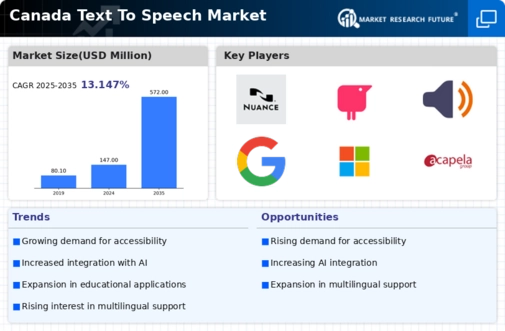Growth in E-Learning Platforms
The expansion of e-learning platforms in Canada is significantly impacting the text to-speech market. With the rise of online education, there is a growing need for tools that facilitate learning for diverse audiences, including those with disabilities. Text to-speech technology plays a crucial role in making educational content more accessible. Recent statistics indicate that the e-learning market in Canada is expected to reach $5 billion by 2026, with a substantial portion of this growth attributed to the integration of text to-speech features. This trend suggests that educational institutions and content creators are increasingly recognizing the value of incorporating speech synthesis to enhance learning outcomes.
Rising Demand for Voice Assistants
The increasing adoption of voice assistants in Canada is driving the text to-speech market. As consumers become more accustomed to interacting with devices through voice commands, the need for natural-sounding speech synthesis grows. This trend is evident in various sectors, including smart home devices, smartphones, and customer service applications. According to recent data, the voice assistant market in Canada is projected to grow at a CAGR of approximately 20% over the next five years. This surge in demand for voice-enabled technology is likely to propel the text to-speech market, as companies seek to enhance user experience through improved speech quality and responsiveness.
Increased Focus on Content Localization
As Canadian businesses expand their reach, there is a heightened emphasis on content localization, which is driving the text to-speech market. Companies are recognizing the importance of tailoring their messaging to resonate with local audiences, necessitating the use of multilingual text to-speech solutions. This trend is particularly relevant in sectors such as marketing, where personalized communication can significantly impact customer engagement. Data suggests that businesses investing in localization strategies can see an increase in customer retention rates by up to 30%. Consequently, the demand for advanced text to-speech technology that supports multiple languages is likely to grow, further propelling the market.
Rising Adoption in Healthcare Applications
The healthcare sector in Canada is increasingly adopting text to-speech technology, which serves as a key driver for the market. This technology is utilized in various applications, including patient communication, telehealth services, and assistive devices for individuals with speech impairments. The growing emphasis on patient-centered care and the need for efficient communication solutions are propelling the demand for text to-speech systems. Recent reports indicate that the telehealth market in Canada is expected to reach $1.5 billion by 2027, with text to-speech technology playing a vital role in enhancing service delivery. This trend suggests that the healthcare industry's reliance on text to-speech solutions will continue to expand.
Advancements in Natural Language Processing
The text to-speech market is experiencing growth due to advancements in natural language processing (NLP) technologies. These innovations enable more accurate and human-like speech synthesis, enhancing user experience across various applications. In Canada, companies are increasingly adopting NLP-driven text to-speech solutions to improve customer interactions and streamline operations. The NLP market is projected to grow at a CAGR of 15% over the next five years, indicating a strong correlation with the text to-speech market. As businesses seek to leverage these advancements, the demand for sophisticated text to-speech systems that can understand context and deliver nuanced speech is likely to rise.



















Leave a Comment